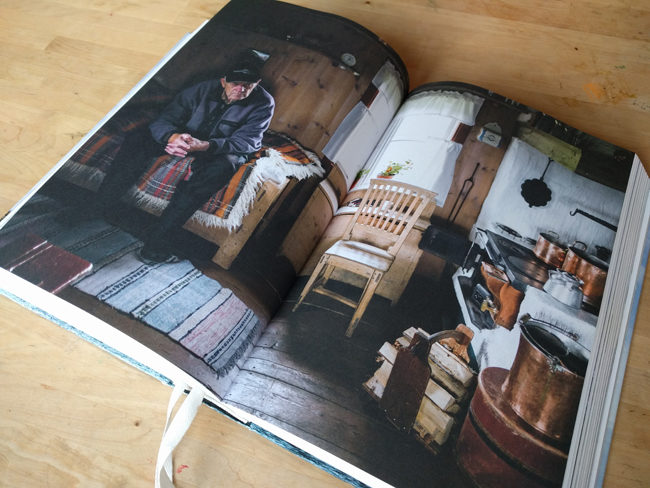
At Fäviken, Magnus Nilsson’s restaurant 400 miles north of Stockholm, the prix fixe tasting menu involves (among many other exquisitely, obsessively local things) lichen, raw cow’s heart, vegetables cooked over “autumn leaves,” foraged scallops smoked over juniper branches, pig’s blood, and cow’s colostrum.
His first book, also called Fäviken, is not, then, really a cookbook. It’s another way to experience a restaurant that only a dozen people a night can enjoy, and only at great expense and through great good fortune. (You want reservations? Good luck.) It’s an invitation to think differently about food and flavors and where those things come from, divorced entirely from the modern need to put dinner on the table every night, and yet knotted tightly to the way people in the north of Sweden and Norway once survived.

Naturally, then, when I picked up Nilsson’s second book, The Nordic Cookbook ($50, Phaidon), the dish I immediately decided to make was Flygande Jakob — Flying Jacob. It became something of an obsession: roast chicken, a packet of dried Italian dressing mix, whipped heavy cream, Heinz chili sauce (apparently, the brand is important), peanuts, bacon, and — this delights me no end — bananas.
Flygande Jakob. It’s ridiculous. It’s crazy processed — an absolute salt bomb, by the way. It’s childishly exotic. It comes from an entirely different planet than does smoked reindeer lichen. And it proves that Swedes, all this new Nordic artistry notwithstanding, are just like us. (Milk-cheeked children eating nothing but berries and salmon and rye crackers after hiking the fjords — pshaw.)
Of course they are. I knew that. You knew that. But how wonderful it is to see it proven in a casserole that would be right at home next to a Jell-O salad.

When I asked some friends in Sweden and Finland to confirm that such a thing as Flygande Jakob existed, one replied, “Sadly, yes.” And the other, a Finn, presented it as evidence of Swedes’ “adorable weirdness.” (It had crossed my mind that this recipe was somehow akin to Van Halen’s touring rider requiring that all brown M&Ms be removed from the green room: a way of testing out who had actually read the book.)
Nilsson himself describes Flygande Jakob with gentle, nostalgic love in the recipe header:
“This dish is one that every Swede who grew up after 1980 has a relationship with, and most of those growing up before too for that matter. … The combination of chicken, cream, Heinz chili sauce, salted peanuts and one of Sweden’s most cherished fruits, the banana, is truly spectacular and one of the strongest lasting cultural expressions of the early 1980s, at least in my opinion. … Serve flygande Jakob with white rice, shredded iceberg lettuce and cucumber (no vinegar, please), then lean back, close your eyes, and pretend you are me eating in 1989 and enjoy yourself.”

And that’s The Nordic Cookbook in a nutshell: real home cooking from Sweden, Norway, Finland, Denmark, Iceland, and the Faroe Islands. Some of it delightfully retro (tacopaj — say it out loud and you’ll get it — is next on my list), some of it deliciously rustic (I have nothing against berries or salmon or rye bread or milk-cheeked children), and some of it fascinatingly inaccessible (seal, puffin, pilot whale, rotten shark — enough said). All of it filtered through Nilsson’s idiosyncratic, untrained, uneven, inquisitive, intelligent, friendly, and inimitable voice.
Alongside the recipes, Nilsson dots The Nordic Cookbook with short essays and observations lasting from a few sentences to several pages. There seems to be no rhyme or reason to Nilsson’s decision to dip deeply into some foods and subjects while leaving others relatively unexplored, but you’re always glad when he stops to focus. His brief, intense observation of a pilot whale hunt in the Faroe Islands is particularly worth reading. And he includes recipes for both boiled and braised whale, in the same book as his crazy chicken-banana casserole. That, as much as the length of the book (763 pages), can help you understand the scope of Nilsson’s undertaking and the breadth of the region he traveled and explored and tried to wrap his mind around.
While Nilsson was gathering recipes for the book, he brought along his camera. His big, broad open landscapes — full of sky and water and bouldered mossy ground — illustrate the book alongside close cottage interiors with worn wood and mismatched ceramics.

And those photographs, in a way, are bringing him to the Twin Cities. Nilsson is in town this week for a series of events at the American Swedish Institute, including an exhibition of his photographs. Nordic: A Photographic Essay of Landscapes, Food and People runs from June 2 through Aug. 14. Nilsson will be on hand Wednesday for an exhibition preview; a recipe exchange, exhibition tour and chef’s table follow on Friday; and on Saturday he’ll be signing books. (Event details are at asimn.org.) Throughout the summer, ASI will host cocktail tours, craft workshops, and cooking classes tied to the exhibition.
I kind of doubt that Flygande Jakob will be on the menu. As the ABBA — no, actually, the Ace of Base — of Nordic food, it’s not the sort of thing you pull out at a dinner party. But it is as quintessentially Nordic as reindeer lichen and cloudberries. And as I peer deep into the landscapes at the exhibition, I’m going to picture a little house, just over the hill, where a young Magnus is eating creamed chicken and bananas.


I’m disappointed that you didn’t make more of an effort to test the cake-stuffed puffin recipe, Tricia. I expect HT writers to go that extra (couple thousand) miles….
Also, the caption on the photo of the seated man is priceless: “Man thinking about something and interior of traditional north Swedish mountain farm house.”
Great piece! Cheers~ Brett
I am sad that I will not get a chance to pinch his rosy cheeks.